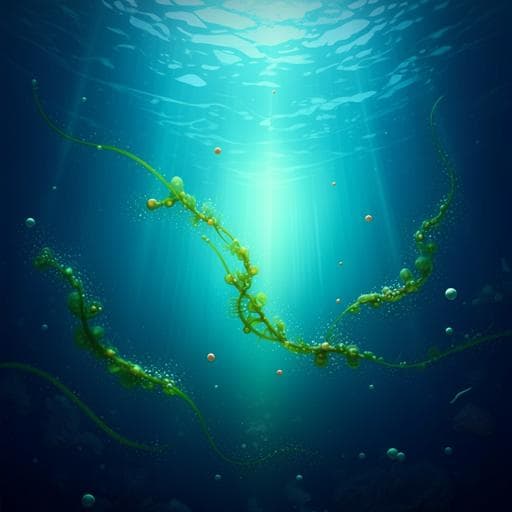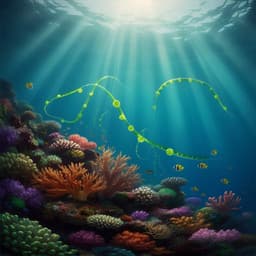
Earth Sciences
Photoacclimation by phytoplankton determines the distribution of global subsurface chlorophyll maxima in the ocean
Y. Masuda, Y. Yamanaka, et al.
This research by Yoshio Masuda and colleagues reveals how resource allocation strategies in phytoplankton influence chlorophyll distribution across oceans. By applying an innovative photoacclimation theory, the study uncovers the underlying drivers of subsurface chlorophyll maxima, providing crucial insights for understanding phytoplankton responses to climate change.
~3 min • Beginner • English
Introduction
The study addresses why subsurface chlorophyll maxima (SCM) are ubiquitous and often deeper than biomass maxima, and seeks a mechanistic explanation for their global distribution. Phytoplankton photoacclimate to light by adjusting intracellular chlorophyll relative to carbon (chl:C), a process further constrained by nutrients and temperature. Laboratory and field data show large variability in cellular chl:C, and prior empirical models have linked chl:C to environmental drivers. SCM depths vary regionally (deep in subtropics, shallow in subpolar waters) and are associated with the nutricline, but the role of photoacclimation outside subtropical regions has been unclear. The authors hypothesize that optimal resource allocation between nutrient uptake and light harvesting (photoacclimation) governs global patterns of cellular chl:C and thus determines SCM depth and intensity across ocean regimes. They test this by embedding an optimality-based photoacclimation model (FlexPFT) within a global biogeochemical ocean circulation model.
Literature Review
Prior work established that phytoplankton adjust chl:C with light, nutrients, and temperature, with empirical and regulatory models proposed (e.g., Geider 1998) and satellite-based primary production models incorporating photoacclimation. Observations document widespread SCM across subtropical, equatorial, subpolar, polar, and upwelling regions, with SCM depth linked to nutricline depth. In subtropics, SCM are often attributed to photoacclimation (increasing chl:C with depth), whereas in equatorial regions studies disagree on whether SCM reflect photoacclimation or biomass peaks. The mechanistic role of photoacclimation in high-nutrient (subpolar, polar, upwelling) regions remains debated. Optimality-based resource allocation theory (Pahlow and subsequent studies) provides a mechanistic framework for acclimation, linking intracellular allocation to environmental conditions and deriving classical quota models, and has reproduced incubation results. This study builds on these theoretical advances to evaluate SCM formation mechanisms globally.
Methodology
The authors coupled the optimality-based Flexible Phytoplankton Functional Type model (FlexPFT; Smith et al. 2016) to a global Ocean General Circulation Model (MRI.COM3). MRI.COM3 has 1° longitude × 0.5° latitude resolution (south of 64°N; tripolar grid north of 64°N) and 51 vertical layers; tracer depths in the upper 160 m include 2.0, 6.5, 12.25, 19.25, 27.5, 37.75, 50.5, 65.5, 82.25, 100.0, 118.2, 137.5, and 157.75 m. It is forced by realistic wind stress, surface heat, and freshwater fluxes. The marine ecosystem component includes a single generic phytoplankton type, zooplankton, nitrate, ammonia, dissolved and particulate organic nitrogen, dissolved and particulate iron. The 3D FlexPFT implementation introduces iron limitation and uses nitrogen-based phytoplankton biomass. The iron cycle includes scavenging and inputs from dust and sediments; dissolved iron is initialized from a Biogeochemical Elemental Cycling model, and nitrate from the World Ocean Database. The model is spun up and run for a 20-year historical simulation (1985–2004). Case studies vary the chlorophyll-specific initial slope of growth versus irradiance (α) from a standard 0.35 to 0.5 and 1.0 m² E⁻¹ mol C (g chl)⁻¹, with case years 2003–2004 starting from end-2002 standard fields.
Physiological framework: Following resource allocation theory, intracellular nitrogen quota (Q) partitions among structural material (Q_s/Q), nutrient uptake (fraction f_v), and light harvesting (1−f_v). Nutrient uptake resources partition between affinity (f_a) and assimilation capacity (1−f_a). Optimal instantaneous acclimation computes daily optimal f_v^o, f_a^o, and Q^o from daily-averaged temperature, irradiance, nitrogen, and iron. Carbon fixation µ′ depends on light, temperature, and iron via a saturating light response function S(I,T,[Fe]) with iron limitation imposed by µ_limFe; chloroplast chl:C (θ′) increases with decreasing light down to a depth where respiratory costs balance benefits, defined by a threshold irradiance I_in. Cellular chl:C is θ^o=(1−f_v^o)θ′, coupling chloroplast pigment content with allocation to light harvesting. Growth rate per carbon biomass µ balances net fixation and respiration costs of nitrogen uptake and depends on optimized acclimation variables; circadian irradiance drives diurnal growth variability while optimization is daily. Chlorophyll-proportional respiration is included. Zooplankton grazing follows a temperature-dependent Holling formulation. Once phytoplankton nitrogen is updated, carbon and chlorophyll concentrations are diagnostically determined from Q^o and θ^o, enabling efficient representation of stoichiometric flexibility.
Model evaluation and analyses: The authors compare simulated surface chlorophyll, nitrate, and primary production patterns to satellite and in situ data, and analyze meridional sections and representative vertical profiles across subtropical, equatorial, subpolar, Antarctic, and upwelling regions. They map global SCM depth (February and August) and relate SCM to nutricline depth, chloroplast chl:C maxima, and resource allocation profiles. Sensitivity to α explores impacts on SCM depth and chlorophyll distribution.
Key Findings
- The model reproduces regional differences in SCM depth across subtropical, equatorial, and subpolar basins and places SCM near the nutricline, where vertical nutrient gradients are steep.
- Chlorophyll is the product of phytoplankton carbon biomass (phyC) and cellular chl:C; phyC generally peaks at the surface, while cellular chl:C peaks deeper (typically 60–130 m), explaining why SCM do not coincide with biomass maxima.
- Subtropical region: SCM occurs at ~118 m; phyC there is ~1/3 of the surface value, while cellular chl:C is ~50× the surface value, placing SCM near the depth of maximum cellular chl:C (deep SCM).
- Subpolar region: SCM is shallow (~28 m). Surface cellular chl:C is ~1/5 of its subsurface maximum (at ~82 m), while surface phyC is ~16× the value at 82 m; SCM aligns more with the phyC maximum near the surface.
- Similar mechanisms apply at the equator, in the Antarctic, and in upwelling regions: SCM depth reflects the balance between surface deficits in cellular chl:C and subsurface increases, modulated by phyC profiles.
- Cellular chl:C is the product of chloroplast chl:C (θ′; primarily light-dependent) and the fractional resource allocation to the chloroplast (1−f_v). Chloroplast θ′ increases with depth to a maximum (≈90 m in equatorial, ≈50 m in subpolar regions) then declines as costs outweigh benefits. Below ~130 m, allocation strongly favors the chloroplast in all regions due to low light; above ~130 m, allocation reflects nutrient status (subtropics favor nutrient uptake, subpolar more balanced), driving regional cellular chl:C patterns and thus SCM depth.
- The model provides a mechanistic basis linking SCM depth to nutricline depth: steep nutrient increases across the nutricline drive sharp increases in allocation to chloroplasts and cellular chl:C, producing SCM near the nutricline.
- Global SCM maps (February and August) show ubiquitous SCM with shallower depths toward coasts, shallowing in upwelling regions, sharp transitions across subtropical–subpolar boundaries, and summer Arctic/Antarctic SCM depths of ~50–65 m, consistent with observations and satellite-derived estimates.
- Sensitivity: Increasing α deepens SCM and increases chlorophyll near SCM, improving deep chlorophyll reproduction but degrading surface chlorophyll agreement, highlighting trait variability effects.
Discussion
The results demonstrate that optimal photoacclimation—resource allocation between nutrient uptake and light harvesting—provides a unifying, mechanistic explanation for the global distribution, depth, and intensity of SCM across diverse oceanic regions. By explicitly linking cellular-scale physiology (chloroplast pigment content and allocation) to bulk chlorophyll, the study clarifies why SCM commonly occur below biomass maxima and why their depth correlates with the nutricline: nutrient increases at the nutricline drive greater chloroplast allocation and cellular chl:C, while light controls chloroplast pigment content. Regional nutrient regimes modulate allocation patterns, producing deep SCM in oligotrophic subtropics and shallow SCM in nutrient-rich subpolar and upwelling regions. This framework improves interpretation of chlorophyll observations (which are not direct biomass proxies) and supports more reliable projections of phytoplankton responses under changing light, temperature, stratification, and nutrient supply in a warming climate.
Conclusion
By embedding optimality-based photoacclimation theory in a global biogeochemical ocean model, the study establishes a mechanistic link between phytoplankton resource allocation strategies and global SCM patterns. Photoacclimation consistently explains observed regional differences in SCM depth and intensity and their relationship to the nutricline. This advances the physiological basis for interpreting ocean chlorophyll and strengthens the foundation for climate-change impact assessments on phytoplankton and marine ecosystems. Future work should incorporate multiple phytoplankton functional types with distinct photoacclimation traits to better capture surface vs. deep communities, improve vertical and horizontal resolution to resolve fine-scale and mesoscale dynamics, include processes such as nitrogen fixation to reduce subtropical biases, and explore variability in key traits (e.g., α) under different environmental regimes.
Limitations
- Single generic phytoplankton type; community composition and lineage-specific photoacclimation differences are not resolved. Sensitivity tests show that increasing α deepens SCM and boosts deep chlorophyll but degrades surface chlorophyll agreement; multiple trait-based types could improve realism.
- Vertical resolution (~10 m scale in upper 160 m) limits representation of fine-scale vertical chlorophyll structure; aggregation due to behavior/buoyancy and thin layers are not resolved.
- Coarse physical resolution precludes mesoscale effects; observed eddies can shift SCM depth substantially (e.g., 80–120 m), beyond the model’s scope.
- Surface chlorophyll in subtropics is underestimated, partly due to absent nitrogen fixers, leading to underestimated primary production in these regions.
- Instantaneous daily acclimation assumption may miss sub-daily acclimation lags, though prior work suggests it approximates dynamic models well.
Related Publications
Explore these studies to deepen your understanding of the subject.







